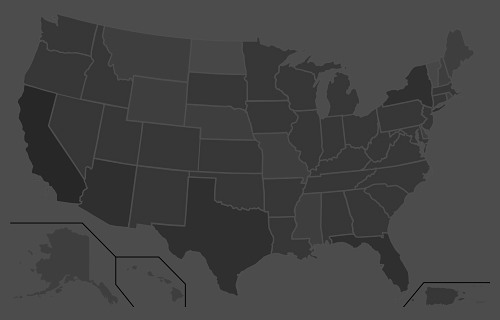“Our added winter moisture and active calling period led to a very long nesting and hatching season, starting in late April and extending into early summer, with chicks hatching as late as early July,” O’Dell said. “From a population standpoint, we are out of a deficit for the first time since 2001-2002. Quail are starting to pop up in places they haven’t been seen in a while.
“If you’ve never had the chance to experience what Arizona quail hunting built its name on, then this would be the year to get out and enjoy it.”
Meanwhile, hunters should note that the season for Mearns’ quail doesn’t begin until Dec. 4. It’s summer rainfall that plays a key role in nesting success and population numbers of this species. After a spotty and relatively weak monsoon across southern Arizona, these birds are likely to be abundant only in pockets that received sufficient precipitation this summer.
A valid Arizona hunting or combination hunt and fish license is required for all hunters 10 and older. Those hunters under 10 must either have a valid hunting or combination hunt and fish license, or be accompanied by an adult who possesses a valid hunting or combination hunt and fish license. Licenses can be purchased online or at license dealers statewide. A youth combination hunt and fish license (ages 10 to 17) is $5.
The general bag limit is 15 quail per day in the aggregate, of which no more than eight may be Mearns’ quail (when the Mearns’ season opens Dec. 4). The general possession limit is 45 quail in the aggregate after opening day, of which no more than 15 Gambel’s, scaled or California quail in the aggregate may be taken in any one day. After the opening of the Mearns’ season, the 45-quail possession limit may include 24 Mearns’ quail, of which no more than eight may be taken in any one day.
More quail-hunting information can be found on the department’s website at https://www.azgfd.com/Hunting/. Another resource for both new and experienced hunters alike is “An Introduction to Hunting Arizona’s Small Game.” Written by Randall D. Babb, the 196-page, full-color book covers where and how to hunt small game birds (like quail), squirrels, rabbits, ducks and geese. It also includes how to prepare and cook your harvest, with illustrations and recipes. The book can be ordered for $16.95 at www.azgfd.gov/publications.
Finally, hunters should check out O’Dell’s techniques for field-dressing quail at https://www.youtube.com/watch?v=3gRwZAcWzzk.
####
Publishers Notes: OUT OF STATE HUNTERS, FISHERMEN & OUTDOOR ENTHUSIASTS; Due to the Covid 19 pandemic, there could be limitations for OUT of STATE hunters, fishermen and other outdoor enthusiasts to include a 14-day quarantine requirement or negative COVID-19 testing alternative. Please check with the State's Department of Natural Resources BEFORE you travel or apply for the 2020 Fall Hunts.
Disclaimer: The views expressed on this site are that of the authors and not necessarily that of TBC Press
Georgia 2021 Turkey Hunting Season Opens March 20
Submitted by: TBC Press
Posted on: 03/15/21
The Backcountry Press
The country's premier daily HUNTING, FISHING & OUTDOOR news in the USA and around the globe. Read whats happening in your neck of the woods & beyond.
© 2020 TBC Press - All Rights Reserved Website Design by:
News # 14270
Unfortunately, the Piedmont region of the state, where many of our hunters focus their efforts, saw a drop in reproduction in 2019, indicating fewer adult birds in the woods. Conversely, reproduction in the Coastal Plain was slightly up, which hopefully is a good sign for hunters in the southern half of the state.
With a bag limit of three gobblers per season, hunters have from Mar. 20 through May 15 to harvest their bird(s).
Georgia Game Check: All turkey hunters must report their harvest using Georgia Game Check. Turkeys can be reported on the Outdoors GA app (georgiawildlife.com/outdoors-ga-app), which now works whether you have cell service or not, at gooutdoorsgeorgia.com, or by calling 1-800-366-2661. App users, if you have not used the app since deer season or before, make sure you have the latest version. More information at georgiawildlife.com/HarvestRecordGeorgiaGameCheck.
Hunters age 16 years or older (including those accompanying youth or others) will need a hunting license and a big game license, unless hunting on their own private land. Get your license at www.gooutdoorsgeorgia.com, at a retail license vendor or by phone at 1-800-366-2661. With many pursuing wild turkeys on private land, hunters are reminded to obtain landowner permission before hunting.
The Georgia Chapter of the National Wild Turkey Federation has donated more than $6,000,000 since 1985 for projects that benefit wild turkey and other wildlife. The NWTF works in partnership with the Wildlife Resources Division and other land management agencies on habitat enhancement, hunter access, wild turkey research and education. The NWTF has a vital initiative called “Save the Habitat, Save the Hunt,” focused on habitat management, hunter access and hunter recruitment.
“Hunters should know that each time they purchase a license or equipment used to turkey hunt, such as shotguns, ammunition and others, that they are part of this greater conservation effort for wildlife in Georgia,” said Rushton. “Through the Wildlife Restoration Program, a portion of the money spent comes back to states and is put back into on-the-ground efforts such as habitat management and species research and management.”
For more hunting information, visit georgiawildlife.com/hunting/hunter-resources.
####
Publishers Notes: Our country is still battling COVID-19. To avoid the spread of this virus and continue to enjoy outdoor activities, ALL outdoor enthusiasts (man, woman, child) should follow the guidelines set by nps.gov. These guidelines include; social distancing, the Leave No Trace principles, including pack-in and pack-out, to keep outdoor spaces safe and healthy.
Georgia turkey hunters are practicing their best turkey calls and patterning their shotguns as they get ready for the statewide 2021 turkey hunting season opening Saturday, Mar. 20, according to the Georgia Department of Natural Resources’ Wildlife Resources Division.
“Statewide reproduction in 2019 was slightly higher than average, which means we should have a fair number of two-year old birds in the woods,” explains Emily Rushton, Wildlife Resources Division wild turkey project coordinator. “However, I don’t expect harvest to reach the levels it did last year, which was a record harvest for many areas of the state, particularly on public lands.”
What can hunters expect across state regions this spring? Harvest in the Ridge and Valley region of the state should remain high, as reproduction was strong in this area. The Blue Ridge Mountain region also saw continued increases in poults per hen, indicating promise of a good harvest.












